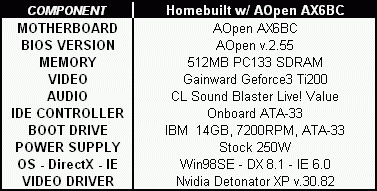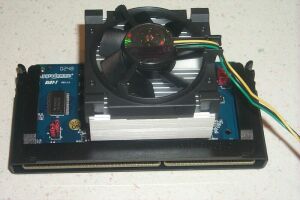| INSTALLATION & START-UP |
The first order of business was to assemble the adapter, processor and heatsink/fan into a complete "rig". This was easily accomplished with the Celeron fitting nicely into the ZIF socket on the Slot-T, followed by attachment of the Intel heatsink/fan that was included in the CPU retail box. A small dab of thermal paste was applied to the heat slug of the processor and to the bottom of the heatsink to facilitate efficient heat transfer, and the heatsink assembly clipped onto the socket frame with minimal difficulty.
Installation into the PC was similarly easy, with the Slot-T sliding into the guides for the motherboard processor slot, and snapping into the slot itself with only moderate force. The Slot-T uses what appears to be exactly the same black plastic frame employed on the PowerLeap ip3/T, with retaining "ears" that lock the seated processor into place. The entire assembly and installation process took no more than 15 minutes. Photos of the assembled rig and the fully installed unit are shown below:
|
|

The PC used for the installation and evaluation of the Slot-T is a homebuilt machine, based upon the AOpen AX6BC motherboard. This mobo can provide processor core voltage down to 1.3V, so the 1.5V requirement for the Tualatin Celeron was no problem. System specs for the PC are shown at right.
With the assembled Slot-T firmly in place, I powered up the machine and was pleased to see the BIOS signal the presence of a 1.3GHz CPU as the PC POST'ed. Windows loaded without incident, and the PC appeared to function normally in all regards. A quick run of WCPUID showed that the processor was properly recognized for type and speed. I then ran through a standard battery of benchmarks (Sandra, PCMark 2002, 3DMark2001SE, UT2003 Flyby/Botmatch, and Q3A Timedemo). I won't bother to show the data here, but suffice it to say that all results were essentially identical to those previously obtained on the machine with a 1.3GHz Tualatin Celeron in a PowerLeap iP3/T. So, clearly this Slot-T adapter WORKS, at least in the short-term.
What remains to be demonstrated is the long-term stability and reliability of the unit, given the high current and wattage loads being borne by the AX6BC's onboard VRM. As I type this, the unit has run for a total of 40 to 50 hours in the PC, so far without any issues. However, that obviously isn't much operating time. I'll continue to monitor the unit and will update this article with any significant new data or developments.
| SUMMARY & RECOMMENDATIONS |
The Slot-T is a product with some strong points, but also some areas of significant concern. Let's enumerate them:
Strengths:
- Good apparent build quality; adapter looks and feels sturdy and well made.
- Jumpers to adjust FSB speed and requested processor core voltage.
- Easy to assemble and install.
- Equivalent CPU performance to PowerLeap iP3/T, as expected, since the CPU itself really determines this.
- Lower total price (adapter, CPU & HSF) than an iP3/T of equivalent clockspeed. Savings is ~$80 vs. a complete, pre-assembled iP3/T, or $30 vs. an iP3/T adapter and separately purchased Intel retail box Celeron and HSF (see details in "BOTTOM LINE", below).
Concerns:
- Lack of onboard VRM. As discussed at length previously, depending on the motherboard that the Slot-T is used with, this could potentially result in over-volting the CPU or long-term stress on the mobo VRM leading to premature component failure. Unfortunately, this is a long-term reliability issue, and will likely only be evident after a significant number of operating hours.
- Though easy to assemble, this definitely adds an element of complexity vs. the pre-assembled iP3/T. Could be an important consideration for hardware "newbies".
- Lack of warranty coverage on the entire fan/CPU/adapter assembly. Individually, these items are covered by Upgradeware (the Slot-T) and Intel (the Celeron and heatsink/fan), but who are you going to call if there's a problem when you push the power button? Also, lack of domestic technical support for US customers.
BOTTOM LINE:
Though the Slot-T is an attractively priced product that does what it purports to do, I cannot in good conscience recommend it broadly to upgraders. The potential problems arising from the lack of onboard VRM introduce an element of risk that is too high to be ignored. While the unit continues to run well in my homebuilt AX6BC-based PC, the effects of running at the high current and power loads required by the Tualatin Celeron processors probably won't be known for a period of hundreds of operating hours. I suspect that for most upgraders, the issue of long-term reliability is more important than an initial cost savings of $80 vs. a pre-assembled iP3/T. The PowerLeap unit, with its patented onboard VRM technology completely removes these elements of risk, and thus remains the preferred CPU upgrade route for older BX systems, in my opinion. The way I see it, you pay more, but you GET more. You also need to factor in PowerLeap's "bumper-to-bumper" warranty coverage, assembly costs and, if you're located in the US, domestic-based technical support as part of the overall value equation.
One other intermediate option should be mentioned, as well. It's possible to buy JUST the iP3/T adapter from PowerLeap for $50, and mate it up with the Tualatin Celeron of your choice, purchased independently. This will allow you to reduce the overall upgrade price by about $50, reducing the price premium for going with the iP3/T to about $30. Of course, you give up the "bumper-to-bumper" warranty coverage (PowerLeap still covers the adapter itself, obviously) and reintroduce the need for assembly. But you still retain the benefits of the onboard VRM technology, which is the key issue in my mind. If you go this route, you'll need to call PowerLeap to order the iP3/T by itself, since that option doesn't appear on their web order page.
Still, the attractiveness of the Slot-T price and performance can't be denied for the cash-strapped upgrader who doesn't mind taking a risk. Such people just need to know exactly what they're getting into and be certain that they can live with the consequences of that choice, if the added strain on their motherboard VRM proves to be too much at some point.
|
Posted Feb. 18, 2003
Questions or comments? E-mail me at THIS LINK |
|


